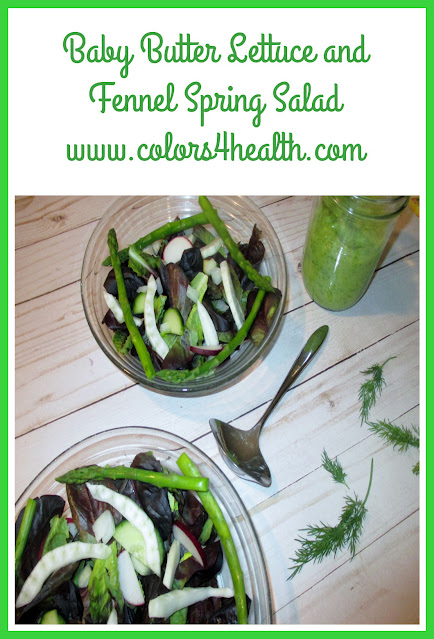Spring is a great time to enjoy a light, crunchy salad of baby butter lettuce, fennel, asparagus, radish, and avocado dill dressing. This whole food plant-based (WFPB) dish is both
scrumptious and healthy.
Research shows the fresher and more color-rich the produce, the
healthier it is to eat.
Fruits and vegetables that are grown locally, allowed to ripen
naturally, and consumed shortly after harvesting, contain higher levels of
vitamins, minerals and antioxidants, than produce that has to be transported from far away.
Locally grown in-season fruits and veggies are usually less expensive, more eco-friendly, and makes simple ingredients pop with flavor.
I prefer to buy organic produce, whenever possible, because organic farming works in harmony
to sustain a healthy, fertile, and biologically active environment, one that is kind to people, animals, and our planet.
Baby Butter Lettuce and Fennel Spring Salad
Fresh, Crisp, and Clean!
Light, yet Nutrient Dense and Delicious!
Oil-free, Sugar-free, Gluten-free, and Vegan!
Smart Choice for Lunch or Dinner!
Ingredients for Salad:
6 cups baby green and/or red butter lettuce
1 large bulb fennel sliced thin
1 bunch red or multicolored radishes sliced thin
1 medium chopped sweet onion or 4-5 chopped scallions (optional)
16 stalks cooked asparagus (select stalks that are thin. Those are the most tender)
1 seedless cucumber chopped (optional)
Ingredients for Avocado Dill
Dressing:
1/2 cup freshly squeezed lemon juice
2 teaspoons apple cider vinegar
1/2 cup water
1 large or 2 small avocados
1/2 cup fresh chopped dill
1/2 teaspoon dried oregano and fresh ground black pepper to taste
What to do-
1. Wash and prep all salad ingredients.
2. Place them in a covered salad bowl and refrigerate until ready to serve.
3. Right before serving, whisk, blend, mash, or process the salad dressing ingredients together, and pour over salad. Toss and serve immediately.
This recipe serves four people. Refrigerate extra portions, but use within a day or two.
Questions and Answers About Main Ingredients
What is
fennel?
Fennel
is a member of the carrot family, though not a root vegetable. The base
grows above ground into a thick, crisp bulb. Above the bulb, you’ll
see stalks with light, feathery leaves that resemble dill.
When fennel goes to
seed, it produces small yellow flowers among the leaves. Every part of the fennel
plant is edible.
Recipes most often use the bulb, but you can finely
mince the fronds to use as an aromatic garnish for salads, soups, or pasta. If you
prefer, save the fennel stalks and leaves to add a sweet note to homemade vegetable broth.
Fennel may look like a feather-topped, potbellied relative to
celery. However, its flavor is remarkably different.
The white bulb and bright
green fronds have a gentle, slightly sweet anise (licorice) flavor. It's crunchy, cleansing, and refreshing to the palate. It's a great addition to any salad.
Why are asparagus a wonderful veggie?
Asparagus tastes yummy and is so healthy. It's easy to prepare, has a pleasing texture, and tastes naturally sweet. See how to cook asparagus properly, and nutrition facts at Asparagus Spring Veggie for Wellness.
Why use an avocado instead of oil in salad dressing?
Reducing overall oil from our diet is a heart-healthy
move. Although avocados are high in fat, they contain “good” fats like omega-3
fatty acids that make us feel full and reduce the urge to overeat.
Avocado is a green fleshed fruit that is nutrient dense and tastes
sensual.
Enjoy recipes that include avocados, as you’ll get nutrients including
vitamins C, E, K, and B-6,potassium, niacin, folate, magnesium and more. For more about avocados see Benefits
of Eating Avocados with Serving Ideas.
When is a good time to use dill?
Dill can elevate the flavor of
various dishes, and is commonly found in European and Asian cuisines.
Dill's flavor
diminishes rapidly during the cooking process, so it is most often added to hot
dishes at the end of cooking or used in cold dishes including salads, pickles, and
dressings.
Why is baby butter lettuce delicious?
This variety of lettuce is at its peak in the spring and fall and flavorful during March, April, and May. The leaves are soft, tender, and mildly sweet. Each leaf is approximately half the size of regular size butter lettuce. The smaller size makes it attractive, more tender, and easier to prepare.
When this type of lettuce is not available, use Bibb or red or green leaf lettuce as a substitute.
Baby butter lettuce is nutritious, colorful, and adds fiber and plant-powered protein to salads, sandwiches, and as a garnish for other dishes.
Baby butter
lettuce is a good source of calcium, iron, potassium, Vitamin A, and Vitamin C. One quarter cup (85g) has 20 calories, and is a fat-free whole food way to get many vitamins, minerals, and antioxidants.










